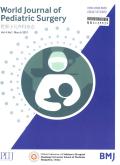The role of extracorporeal life support and timing of repair in infants with congenital diaphragmatic hernia
IF 0.8
4区 医学
Q4 PEDIATRICS
引用次数: 0
Abstract
Extracorporeal life support (ECLS) serves as a rescue therapy for patients with congenital diaphragmatic hernia (CDH) and severe cardiopulmonary failure, and only half of these patients survive to discharge. This costly intervention has a significant complication risk and is reserved for patients with the most severe disease physiology refractory to maximal cardiopulmonary support. Some contraindications to ECLS do exist such as coagulopathy, lethal chromosomal or congenital anomaly, very preterm birth, or very low birth weight, but many of these limits are being evaluated through further research. Consensus guidelines from the past decade vary in recommendations for ECLS use in patients with CDH but this therapy appears to have a survival benefit in the most severe subset of patients. Improved outcomes have been observed for patients treated at high-volume centers. This review details the evolving literature surrounding management paradigms for timing of CDH repair for patients receiving preoperative ECLS. Most recent data support early repair following cannulation to avoid non-repair which is uniformly fatal in this population. Longer ECLS runs are associated with decreased survival, and patient physiology should guide ECLS weaning and eventual decannulation rather than limiting patients to arbitrary run lengths. Standardization of care across centers is a major focus to limit unnecessary costs and improve short-term and long-term outcomes for these complex patients. No data are available.体外生命支持的作用和先天性膈疝婴儿的修复时机
体外生命支持(ECLS)是先天性膈疝(CDH)和严重心肺功能衰竭患者的一种抢救疗法,这些患者中只有一半能存活到出院。这种费用高昂的干预措施有很大的并发症风险,仅适用于最大限度心肺支持无效的最严重疾病患者。ECLS 确实存在一些禁忌症,如凝血功能障碍、致死性染色体或先天性异常、极早产或极低出生体重,但其中许多限制正在通过进一步研究进行评估。过去十年的共识指南对 CDH 患者使用 ECLS 的建议不尽相同,但这种疗法似乎对最严重亚群患者的生存有好处。据观察,在高容量中心接受治疗的患者的预后有所改善。本综述详细介绍了围绕术前接受 ECLS 患者 CDH 修复时机的管理范式不断发展的文献。最近的大多数数据都支持在插管后尽早进行修复,以避免未修复的情况发生,因为未修复的情况在这类患者中都是致命的。较长的 ECLS 运行时间与存活率下降有关,患者的生理状况应指导 ECLS 的断流和最终停用,而不是任意限制患者的运行时间。为了限制不必要的费用并改善这些复杂患者的短期和长期预后,各中心的标准化护理是一个重点。暂无数据。
本文章由计算机程序翻译,如有差异,请以英文原文为准。
求助全文
约1分钟内获得全文
求助全文

 求助内容:
求助内容: 应助结果提醒方式:
应助结果提醒方式:


